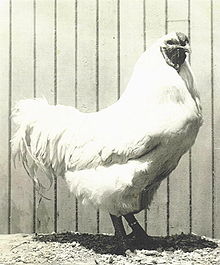
The American Game is an American breed of game fowl, chickens bred specifically for cockfighting. It has many color varieties, and may also be kept for ornament.

The Rhode Island Red is an American breed of domestic chicken. It is the state bird of Rhode Island. It was developed there and in Massachusetts in the late nineteenth century, by cross-breeding birds of Oriental origin such as the Malay with brown Leghorn birds from Italy. It was a dual-purpose breed, raised both for meat and for eggs; modern strains have been bred for their egg-laying abilities. The traditional non-industrial strains of the Rhode Island Red are listed as "watch" by The Livestock Conservancy. It is a separate breed to the Rhode Island White.

The Cochin is a breed of large domestic chicken. It derives from large feather-legged chickens brought from China to Europe and North America in the 1840s and 1850s. It is reared principally for exhibition. It was formerly known as Cochin-China.
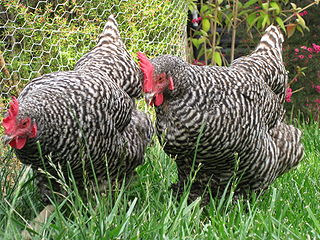
The Plymouth Rock is an American breed of domestic chicken. It was first seen in Massachusetts in the nineteenth century and for much of the early twentieth century was the most widely kept chicken breed in the United States. It is a dual-purpose bird, raised both for its meat and for its brown eggs. It is resistant to cold, easy to manage, and a good sitter.

The Wyandotte is an American breed of chicken developed in the 1870s. It was named for the indigenous Wyandot people of North America. The Wyandotte is a dual-purpose breed, kept for its brown eggs and its yellow-skinned meat. It is a popular show bird, and has many color variants. It was originally known as the American Sebright.
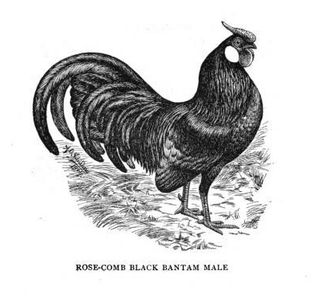
The Rosecomb is a breed of chicken named for its distinctive comb. Rosecombs are bantam chickens, and are among those known as true bantams, meaning they are not a miniaturised version of a large fowl. Rosecombs are one of the oldest and most popular bantam breeds in showing, and thus have numerous variations within the breed. An ornamental chicken, they are poor egg layers and not suited for meat production.

The California Gray is an American breed of domestic chicken. It may be also known as the "production black".

The Buckeye is an American breed of chicken. It was created in Ohio in the late nineteenth century by Nettie Metcalf. The color of its plumage was intended to resemble the color of the seeds of Aesculus glabra, the Ohio Buckeye plant for which the state is called the 'Buckeye State'.
The Nankin Bantam or Nankin is a British bantam breed of chicken. It is a true bantam, a naturally small breed with no large counterpart from which it was miniaturised. It is of South-east Asian origin, and is among the oldest bantam breeds. It is a yellowish buff colour, and the name is thought to derive from the colour of nankeen cotton from China.

The Rhode Island White is a breed of chicken originating in the U.S. state of Rhode Island. Despite their very similar names and shared place of origin, the Rhode Island White is a distinct breed from the Rhode Island Red. However, Rhode Island Reds and Whites can be bred together to create Red Sex-Link hybrid chickens, such as the ISA Brown. In Australia, the Rhode Island White is regarded as a color variety of the Rhode Island breed according to the Australian Poultry Standards.

The Delaware is a breed of chicken originating in the U.S. state of Delaware. It was once of relative importance to the U.S. chicken industry, but today is critically endangered. It is primarily suited to meat production but also lays reasonably well. It has plumage of a unique pattern, and is accepted into poultry standards for showing.

The Java is a breed of chicken originating in the United States. Despite the breed's name, a reference to the island of Java, it was developed in the U.S. from chickens of unknown Asian extraction. It is one of the oldest American chickens, forming the basis for many other breeds, but is critically endangered today. Javas are large birds with a sturdy appearance. They are hardy, and are well-suited for both meat and egg production, especially by small-scale farms, homesteads, and backyard keepers.
The Iowa Blue is a breed of chicken that originated near Decorah, Iowa, in the early twentieth century. Despite its name, the breed is not actually blue according to poultry standards. It is an exceedingly rare fowl, and is not recognized for showing by the American Poultry Association. They are a dual-purpose breed laying brown eggs and known to be good foragers.
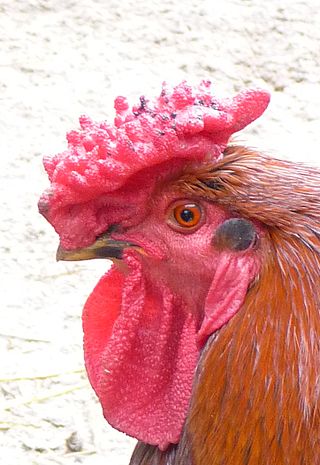
The Derbyshire Redcap is a breed of chicken originating in the English county of Derbyshire. The name "Redcap" derives from the breed's unusually large Rose-type comb. British breed standards dictate a length of more than 7 centimetres (3 inches) of length for a Redcap comb. It is covered in small, fleshy points, and has a distinct spike pointing backwards called a "leader". Combs, wattles and earlobes are all ideally bright red.
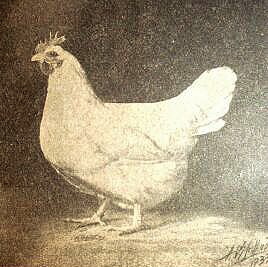
The Lamona is an American breed of chicken. It was developed from 1912 by Harry S. Lamon, who was the senior poultry expert of the Bureau of Animal Industry, at the Beltsville Agricultural Research Center of the U.S. Department of Agriculture in Beltsville, Maryland.

The Bronze is a breed of domestic turkey. The name refers to its plumage, which bears an iridescent bronze-like sheen. The Bronze had been the most popular turkey throughout most of American history, but waned in popularity beginning in the mid-20th century. Later in its history, the breed was divided into two distinct types: the Broad Breasted Bronze and the Standard Bronze. A great deal of confusion exists about the difference between Standard and Broad Breasted Bronzes, or whether there is any difference at all. Collectively, the Standard and Broad Breasted varieties are simply called the Bronze turkey.
The Slate, or Blue Slate, is a breed of domestic turkey known for the slate gray color of its plumage. Lighter birds are sometimes called Lavender turkeys. Turkeys of the Slate breed may actually be any number of shades between pure black and white, but only ash-gray birds are eligible for showing under the directive of the American Poultry Association’s ‘’Standard of Perfection’’, into which they admitted as a variety in 1874. Slate turkeys are listed as critically endangered by the American Livestock Breeds Conservancy, and meet the definition of a heritage turkey breed.
The chicken breeds recognized by the American Poultry Association are listed in the American Standard of Perfection. They are categorized into classes: standard-sized breeds are grouped by type or by place of origin, while bantam breeds are classified according to type or physical characteristics.

Nettie Metcalf was an American farmer from Warren, Ohio. She is best known for creating the Buckeye chicken breed, which was officiated by the American Poultry Association in February 1905. Metcalf attended poultry meetings across North America and became President of the American Buckeye Club. She is the only woman recorded by the American Poultry Association to create a chicken breed.
